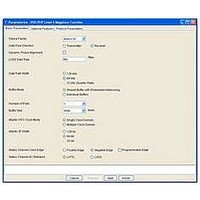IPR-POSPHY4 Altera, IPR-POSPHY4 Datasheet - Page 31

IPR-POSPHY4
Manufacturer Part Number
IPR-POSPHY4
Description
IP CORE Renewal Of IP-POSPHY4
Manufacturer
Altera
Type
MegaCorer
Specifications of IPR-POSPHY4
Software Application
IP CORE, Interface And Protocols, COMMUNICATION
Supported Families
Arria GX, Cyclone, HardCopy, Stratix
Core Architecture
FPGA
Core Sub-architecture
Arria, Cyclone, Stratix
Rohs Compliant
NA
Function
POS-PHY Level 4 Interface, Link-Layer/PHY Layer
License
Renewal License
Lead Free Status / RoHS Status
na
Lead Free Status / RoHS Status
na
- Current page: 31 of 144
- Download datasheet (3Mb)
Chapter 3: Parameter Settings
Optional Features
December 2010 Altera Corporation
In some cases, it is better to ignore this signal and rely on the error checking
mechanisms or SPI4.2, by checking the DIP4 calculation. You then have to externally
request the retraining and unlock the DPA block.
It is normal during the normal data transfer in SPI-4.2 that dpa_locked signal can
become de-asserted due to some jitter that is still within 0.44 UI of LVDS data. The
DPA has a low pass filter that filters out very high frequency jitter from affecting the
lock signal and phase of rx_clk. If the jitter is detected to be 0.25 UI (two phases out of
8 jump in one direction), dpa_locked is de-asserted and it is still within 0.44 UI.
The DIP-4 error marking determines how the receiver handles DIP-4 errors. The
receiver uses the following three modes to mark received DIP-4 errors:
■
■
■
End-of-packet-based data available controls the aN_arxdav signal on the Atlantic
FIFO buffer. Turn on so the aN_arxdav signal is asserted (high) when at least one EOP
is in the buffer, or the fill level is above FIFO threshold low (ctl_ax_ftl). Turn off so
the aN_arxdav signal is asserted (high) only if the fill level of the FIFO buffer is above
the FIFO threshold low value.
The Status source option applies only to variations using the shared buffer with
embedded addressing mode and provides the following two status channel control
options:
■
■
Turn on Safe External (User Controlled) Status, to ensure the sent status avoids FIFO
buffer overflow (refer to
to ensure the sent status is always the user status (refer to
buffer fill level.
None—no error marking is performed.
Optimistic mode—the receiver MegaCore function marks the preceding and
succeeding burst as errored. If these bursts are payload (that is, if a DIP-4 occurs
followed by IDLEs), then only the preceding control word payload is marked as
errored. Bursts going into the Atlantic FIFO buffer are marked with the Atlantic
error signal. If a burst is not an EOP, it is up to the user logic to detect it.
Pessimistic mode—the receiver MegaCore function marks all open packets as
errored. Packets going into the Atlantic FIFO buffer are marked with the Atlantic
error signal. This feature increases in resource utilization as the number of ports
increases.
Buffer Fill Level—the status for each channel is controlled by the single buffer’s
status. Every calendar time slot contains the result of the almost empty (AE) and
almost full (AF) comparison to the buffer level.
User Controlled—to add extra pins, which allows you to directly control the
transmitted buffer status and allows you to send a status irrespective of the fill
level of the internal FIFO buffers, which avoids the situation where the FIFO
buffer is not emptied quickly enough, and if you still request data, the FIFO buffer
overfills.
Table
3–3). Turn off Safe External (User Controlled) Status,
POS-PHY Level 4 MegaCore Function User Guide
Table
3–3), irrespective of
3–9
Related parts for IPR-POSPHY4
Image
Part Number
Description
Manufacturer
Datasheet
Request
R

Part Number:
Description:
IP NIOS II MEGACORE RENEW
Manufacturer:
Altera
Datasheet:

Part Number:
Description:
IP CORE Renewal Of IP-XAUIPCS
Manufacturer:
Altera
Datasheet:

Part Number:
Description:
IP CORE Renewal Of IP-10GETHERNET
Manufacturer:
Altera
Datasheet:

Part Number:
Description:
IP CORE Renewal Of IP-ASI
Manufacturer:
Altera
Datasheet:

Part Number:
Description:
IP CORE Renewal Of IP-CIC
Manufacturer:
Altera
Datasheet:

Part Number:
Description:
IP CORE Renewal Of IP-CRC
Manufacturer:
Altera
Datasheet:

Part Number:
Description:
IP CORE Renewal Of IP-ED8B10B
Manufacturer:
Altera
Datasheet:

Part Number:
Description:
CPLD, EP610 Family, ECMOS Process, 300 Gates, 16 Macro Cells, 16 Reg., 16 User I/Os, 5V Supply, 35 Speed Grade, 24DIP
Manufacturer:
Altera Corporation
Datasheet:

Part Number:
Description:
CPLD, EP610 Family, ECMOS Process, 300 Gates, 16 Macro Cells, 16 Reg., 16 User I/Os, 5V Supply, 15 Speed Grade, 24DIP
Manufacturer:
Altera Corporation
Datasheet:

Part Number:
Description:
Manufacturer:
Altera Corporation
Datasheet:










